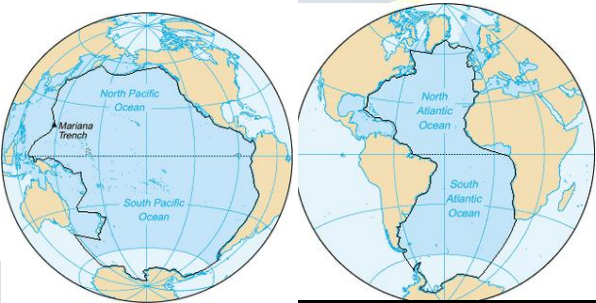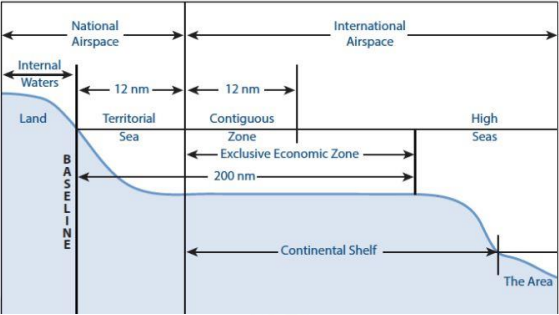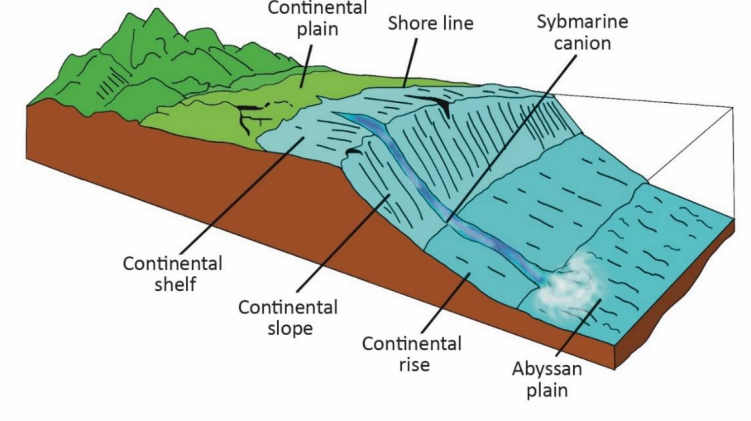Geography Playlist
19 chapters • 0 completed
The Universe and the Earth
18 topics
Atmosphere and its composition
6 topics
Atmospheric Temperature
11 topics
Atmospheric Moisture
9 topics
Air Mass, Fronts & Cyclones
15 topics
Evolution of Earths Crust, Earthquakes and Volcanoes
23 topics
Interior of The Earth
14 topics
Landforms
25 topics
Geomorphic Processes
10 topics
Movement of Ocean Water
16 topics
Oceans and its Properties
12 topics
Climate of a Region
14 topics
Indian Geography - introduction, Geology
5 topics
Physiography of India
27 topics
Indian Climate
20 topics
Indian Drainage
32 topics
Soil and Natural Vegetation
13 topics
Mineral and Energy Resources, Industries in India
28 topics
Indian Agriculture
22 topics
Chapter 11: Oceans and its Properties
Chapter TestOceans of the World & Their Properties
The Pacific is the largest and deepest, Atlantic is the second-largest and historically important, Indian is the youngest and monsoon-driven, Southern regulates Antarctic climate, and Arctic is the smallest and shallowest with unique ice-covered ecosystem.
The Pacific is the largest and deepest, Atlantic is the second-largest and historically important, Indian is the youngest and monsoon-driven, Southern regulates Antarctic climate, and Arctic is the smallest and shallowest with unique ice-covered ecosystem.

Comparison of World’s Oceans
| Ocean | Area | Deepest Point | Key Features |
|---|---|---|---|
| Pacific | 165.2 mn sq. km | Mariana Trench (11,022 m) | Largest, Ring of Fire, max islands |
| Atlantic | 106.4 mn sq. km | Milwaukee Depth (8,380 m) | S-shape, Gulf Stream, trade routes |
| Indian | 70.5 mn sq. km | Java Trench (7,258 m) | Monsoon-driven, landlocked north |
| Southern | 20.3 mn sq. km | South Sandwich Trench (7,236 m) | Antarctic circumpolar current, carbon sink |
| Arctic | 14.0 mn sq. km | Fram Basin (5,550 m) | Smallest, shallowest, ice-covered, oil & gas |
Mains Key Points
Prelims Strategy Tips
Southern Ocean, Arctic Ocean & IHO
The Southern Ocean is the 'newest' named ocean encircling Antarctica, while the Arctic Ocean is the smallest, shallowest, and coldest ocean with unique biodiversity. The International Hydrographic Organization (IHO) standardizes global nautical charts and surveys.
The Southern Ocean is the 'newest' named ocean encircling Antarctica, while the Arctic Ocean is the smallest, shallowest, and coldest ocean with unique biodiversity. The International Hydrographic Organization (IHO) standardizes global nautical charts and surveys.
Comparison of Southern & Arctic Oceans
| Feature | Southern Ocean | Arctic Ocean |
|---|---|---|
| Area | 20.3 mn sq. km | 14.0 mn sq. km |
| Depth | 7,236 m (South Sandwich Trench) | 5,550 m (Fram Basin) |
| Salinity | Normal, mixes with Atlantic & Pacific | Least salty (due to ice melt) |
| Climate Role | Regulates heat & carbon globally | Polar amplification, climate sensitive |
| Biodiversity | Krill, penguins, seals, whales | Fish diversity, whales, seals, jellyfish |
| Strategic Importance | Climate regulation, fisheries | Oil, gas, new shipping lanes |
Mains Key Points
Prelims Strategy Tips
United Nations Convention on the Law of the Sea (UNCLOS) & Maritime Zones
UNCLOS (1982) provides the global legal framework for the oceans. It divides the seas into different maritime zones: Internal Waters, Territorial Sea, Contiguous Zone, Exclusive Economic Zone (EEZ), and High Seas.
UNCLOS (1982) provides the global legal framework for the oceans. It divides the seas into different maritime zones: Internal Waters, Territorial Sea, Contiguous Zone, Exclusive Economic Zone (EEZ), and High Seas.

UNCLOS Maritime Zones
| Zone | Limit from Baseline | Rights of Coastal State |
|---|---|---|
| Internal Waters | Landward of baseline | Full sovereignty, no innocent passage |
| Territorial Sea | 0–12 nm | Full sovereignty, but innocent passage allowed |
| Contiguous Zone | 12–24 nm | Enforce fiscal, immigration, customs, sanitary laws |
| Exclusive Economic Zone (EEZ) | 0–200 nm | Sovereign rights for resources, energy production |
| High Seas | Beyond 200 nm | No sovereignty, free for peaceful use by all states |
Mains Key Points
Prelims Strategy Tips
Ocean Relief – Major Divisions of the Ocean Floor
The ocean floor has four major divisions – Continental Shelf, Continental Slope (including Continental Rise), Deep Sea Plains (Abyssal Plains), and Oceanic Deeps or Trenches.
The ocean floor has four major divisions – Continental Shelf, Continental Slope (including Continental Rise), Deep Sea Plains (Abyssal Plains), and Oceanic Deeps or Trenches.

Major Divisions of Ocean Floor
| Division | Depth/Gradient | Key Features |
|---|---|---|
| Continental Shelf | Shallow, avg. 70 km width, slope ~1° | Fishing grounds, petroleum, natural gas, placer deposits |
| Continental Slope | 200–3000 m depth, slope 2°–5° | Submarine canyons, boundary of continents |
| Continental Rise | Slope 0.5°–1° | Formed of sediments from shelves |
| Abyssal Plains | 3000–6000 m depth | Flat, covered with fine sediments, ridges & guyots |
| Oceanic Trenches | Up to 11,000 m (deepest) | Tectonic origin, earthquakes & volcanism, Mariana Trench deepest |
Mains Key Points
Prelims Strategy Tips
Minor Relief Features of the Ocean Floor
Minor relief features include submarine canyons, seamounts, guyots, mid-oceanic ridges, banks, shoals, and coral reefs. These features influence navigation, fisheries, biodiversity, tectonics, and climate regulation.
Minor relief features include submarine canyons, seamounts, guyots, mid-oceanic ridges, banks, shoals, and coral reefs. These features influence navigation, fisheries, biodiversity, tectonics, and climate regulation.

Minor Ocean Relief Features
| Feature | Characteristics | Examples |
|---|---|---|
| Submarine Canyons | Narrow, steep valleys on continental slopes | Hudson, Columbia, Krishna |
| Seamounts | Underwater volcanic mountains | Emperor Seamount Chain |
| Guyots | Flat-topped seamounts (table mounts) | Kuko, Suiko, Pallada |
| Mid-Oceanic Ridges | Tectonic mountain ranges at divergent boundaries | Mid-Atlantic Ridge |
| Banks | Flat-topped elevations, rich fisheries | Dogger Bank, Grand Banks |
| Shoals | Shallow sediment accumulations, dangerous | Common near river mouths |
| Coral Reefs | Built by corals & algae in shallow seas | Great Barrier Reef |
Mains Key Points
Prelims Strategy Tips
Coral Reefs
Coral reefs are rock-like marine structures built by tiny corals living symbiotically with algae. They thrive in warm, clear, shallow, saline waters with strong sunlight and minimal disturbance. Major reef regions include the Great Barrier Reef, Coral Triangle, and Mesoamerican Reef.
Coral reefs are rock-like marine structures built by tiny corals living symbiotically with algae. They thrive in warm, clear, shallow, saline waters with strong sunlight and minimal disturbance. Major reef regions include the Great Barrier Reef, Coral Triangle, and Mesoamerican Reef.
Ideal Conditions for Coral Growth
| Factor | Requirement | Reason |
|---|---|---|
| Depth & Sunlight | Shallow water (<180 ft) | Sunlight for photosynthesis |
| Temperature | ~27°C, not below 20°C | Sensitive to temperature shock |
| Water Movement | Active circulation | Provides oxygen & plankton |
| Salinity | 30–40 ppt | Freshwater unsuitable, muddy water blocks pores |
| Storms | Low frequency | Strong waves damage reefs |
| Substrate | Hard base (rocks/coral skeletons) | Foundation for reef building |
Mains Key Points
Prelims Strategy Tips
Types of Coral Reefs
Coral reefs occur as fringing reefs, barrier reefs, and atolls. Their formation is linked to volcanic islands, sea-level changes, and subsidence of land. Darwin’s subsidence theory explains the transition from fringing to barrier reefs and eventually to atolls.
Coral reefs occur as fringing reefs, barrier reefs, and atolls. Their formation is linked to volcanic islands, sea-level changes, and subsidence of land. Darwin’s subsidence theory explains the transition from fringing to barrier reefs and eventually to atolls.
Types of Coral Reefs
| Type | Characteristics | Examples |
|---|---|---|
| Fringing Reefs | Nearshore, narrow (1–2 km), shallow lagoon (Boat Channels) | Ningaloo Reef (Australia) |
| Barrier Reefs | Parallel to coast, separated by deep wide lagoons, very extensive | Great Barrier Reef (Australia) |
| Atolls | Ring-shaped, open ocean, formed around submerged volcanic islands, lagoon inside | Marshall Islands, Chagos Archipelago |
Mains Key Points
Prelims Strategy Tips
Services Provided by Coral Reefs
Coral reefs provide provisioning (food, medicine, raw materials), regulating (coastal protection, water filtration), supporting (ecosystem indicators), and cultural (tourism, heritage) services. They support nearly 500 million people worldwide.
Coral reefs provide provisioning (food, medicine, raw materials), regulating (coastal protection, water filtration), supporting (ecosystem indicators), and cultural (tourism, heritage) services. They support nearly 500 million people worldwide.
Ecosystem Services of Coral Reefs
| Category | Functions | Examples |
|---|---|---|
| Provisioning | Food, medicine, raw materials | Seafood, coral jewelry |
| Regulating | Coastal protection, water filtration | Barrier against tsunamis & cyclones |
| Supporting | Habitat & ecosystem indicators | Breeding grounds for fish |
| Cultural | Tourism, cultural values | Great Barrier Reef tourism, Pacific Island traditions |
Mains Key Points
Prelims Strategy Tips
Coral Bleaching & Ocean Deposits
Coral bleaching is caused when corals under stress expel symbiotic zooxanthellae algae, turning white. Ocean deposits are sediments on the sea floor, derived from land, organisms, glaciers, or volcanic activity.
Coral bleaching is caused when corals under stress expel symbiotic zooxanthellae algae, turning white. Ocean deposits are sediments on the sea floor, derived from land, organisms, glaciers, or volcanic activity.
Classification of Ocean Deposits
| Type | Source | Characteristics | Examples |
|---|---|---|---|
| Terrigenous | Land (erosion, rivers, winds) | Mud, silts, clays near shelves | Ganga-Brahmaputra shelf deposits |
| Pelagic (Ooze) | Marine organisms | Fine, flour-like, deep ocean | Globigerina Ooze in Atlantic |
| Glacial Marine | Melting glaciers, icebergs | Mud, sand, boulders in high latitudes | North Atlantic margins |
| Volcanic (Red Clays) | Volcanoes (ash, pumice) | Spread in shallow & deep waters | Pacific 'red clay' beds |
Mains Key Points
Prelims Strategy Tips
Ocean Properties – Temperature of Ocean Water
Ocean water temperature varies with latitude, depth, currents, winds, and regional geography. It regulates climate, monsoon, marine biodiversity, fisheries, and navigation. SST and OMT are vital for climate modeling and monsoon prediction.
Ocean water temperature varies with latitude, depth, currents, winds, and regional geography. It regulates climate, monsoon, marine biodiversity, fisheries, and navigation. SST and OMT are vital for climate modeling and monsoon prediction.
Comparison: SST vs OMT
| Aspect | SST (Sea-Surface Temp.) | OMT (Ocean Mean Temp.) |
|---|---|---|
| Depth | Top few millimeters | Up to 26°C isotherm (~100m) |
| Stability | Highly variable (winds, clouds, evaporation) | Stable, consistent |
| Climatic Use | ENSO detection, short-term forecasting | Better monsoon prediction |
| Spatial Variation | High | Low |
| Indian Context | Predicts seasonal rainfall deviations | Better predictor of IMD monsoon forecast |
Mains Key Points
Prelims Strategy Tips
Salinity of Ocean Water
Average salinity of open oceans is ~35 ppt (parts per thousand). Distribution varies with evaporation, precipitation, river inflow, currents, and ice-melt. Salinity influences thermohaline circulation, marine biodiversity, and global climate.
Average salinity of open oceans is ~35 ppt (parts per thousand). Distribution varies with evaporation, precipitation, river inflow, currents, and ice-melt. Salinity influences thermohaline circulation, marine biodiversity, and global climate.
Horizontal Distribution of Ocean Salinity
| Region | Salinity (ppt) | Reason |
|---|---|---|
| Equator | 34–35 | High rainfall + cloud cover reduces salinity despite high evaporation |
| Tropics (20–30°) | 36–37 | Clear skies, high temp, strong evaporation |
| Polar regions | <30 | Ice-melt + low evaporation |
| Enclosed seas (Red Sea) | ~42 | High evaporation, dry climate |
| Dead Sea | ~200 | Extreme evaporation, no outlet |
Vertical Distribution of Salinity
| Layer | Salinity Pattern |
|---|---|
| Surface layer | Highly variable, influenced by climate & runoff |
| Halocline (100–400m) | Rapid increase in salinity |
| Deep ocean (>1000m) | Stable, uniform salinity |
| Polar oceans | Uniform low salinity, no halocline |
Mains Key Points
Prelims Strategy Tips
Density of Ocean Water
Seawater density ranges between 1.02–1.03 g/cm³, influenced primarily by temperature, salinity, and pressure. Density variations drive ocean stratification, pycnocline formation, and global thermohaline circulation.
Seawater density ranges between 1.02–1.03 g/cm³, influenced primarily by temperature, salinity, and pressure. Density variations drive ocean stratification, pycnocline formation, and global thermohaline circulation.
Factors Influencing Seawater Density
| Factor | Effect on Density | Importance |
|---|---|---|
| Temperature | Cooling ↑ density | Strongest factor; forms thermocline & pycnocline |
| Salinity | Higher salinity ↑ density | Controls vertical mixing & water mass formation |
| Pressure | Slight ↑ with depth | Minor effect, but relevant in deep ocean |
Vertical Structure of Density
| Layer | Density Pattern | Associated Features |
|---|---|---|
| Surface Layer | Low density, variable | Influenced by sun, winds, freshwater inflow |
| Pycnocline (300–1000m) | Sharp increase | Coincides with thermocline |
| Deep Ocean (>1000m) | Stable, high density | Cold, nutrient-rich waters |
Mains Key Points
Prelims Strategy Tips
Chapter Complete!
Ready to move to the next chapter?
